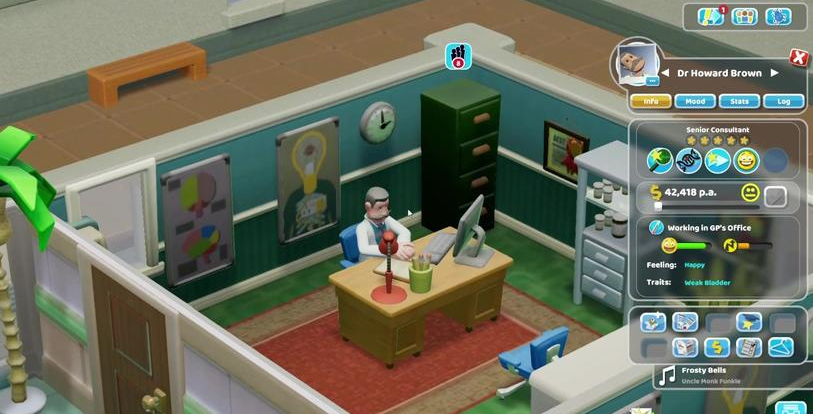Two Point Hospital is not only a simulator of hospital construction and management, but also a complex strategy with a developed economic system, presented with a special humor that many players love. The game is not easy to learn due to the variety of mechanics and numerous game processes, which are impossible to talk about even in several articles. Therefore, I decided to limit myself by preparing stories from the lives of several hospital employees that will help to get acquainted with the key moments of the game and show some of its hidden capabilities. I chose one doctor, one nurse and one cleaner and for each I recorded short videos of their work in the hospital.
It’s interesting to watch each character. Among the work routine, you find comical moments, thanks to which the game has become popular among players.
For observation, I chose the employees of the Croquembouche hospital (French croquembouche) – this is the final level in the game, and it is not named so by chance. In French cuisine, croquembouche (“croquer en bouche” means “crisp in the mouth”) is a delicious cone-shaped dessert consisting of filled profiteroles, most often served at wedding ceremonies, Epiphanies and Christmas. This is the final treat on the holiday table, which is very symbolic for the game.

A little about my hospital
In the world of Two Point Hospital, Croquembouche is located in the Urban Region, in the busiest part of the city center. According to the internal game clock, my hospital has been operating for 22 years and has received more than 6 thousand patients during this time.
The cost of the hospital is more than $8 million. It consists of seven buildings, each of which houses a Reception Room, toilets, a Cafe, and a Staff Room. On the territory (by default) there is one helipad for receiving emergency patients.
The hospital has 15 general practice rooms and all the diagnostic and treatment rooms available in the world of the game, several wards, two surgical rooms, two research laboratories, one staff training room and one marketing department. The offices have the most modern equipment, as all available machine upgrades have been researched .
Over the years of its existence, the hospital has received various awards many times. Most frequently awarded are Employer of the Year (21 times), Top Research Hospital (20 times) and Patient’s Choice (20 times). Six times winner of the “Best Hospital of the Year” award.
Croquembouche employs 110 people. Among them: 38 doctors, 21 nurses, 18 cleaners and 33 assistants to work in the reception, cafe and marketing department.
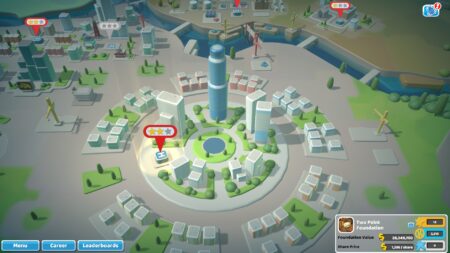
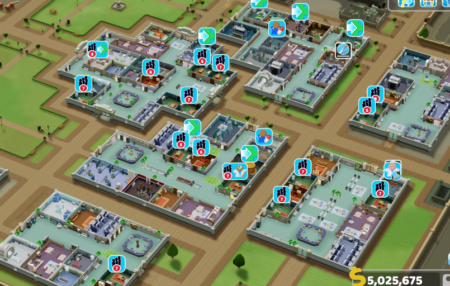
So, let’s start with the story of one doctor.
Dr. Howard Brown
Dr. Howard Brown is a Senior Consultant in the field of General Diagnosis and DNA analysis. He has been working at my hospital for more than 20 years, almost from the very beginning.
In the personal qualities of the doctor:
- Emotional Intelligence, the possession of which increases the happiness of patients after treatment (Happiness).
- Motivation, which increases the speed and efficiency of his work.
What does a doctor do in a hospital?
Since the beginning of my observation, Dr. Howard Brown has been conducting appointments in the GP’s Office. This is the first office where patients are sent after the Reception Desk.
A general practitioner (essentially our therapist) makes a diagnosis and prescribes treatment. If the diagnosis is difficult, the doctor writes a referral to one of the diagnostic rooms. For example, Fluid Analysis, Cardiology and others. After visiting the diagnostics, the patient returns to the general practice office with the test results.
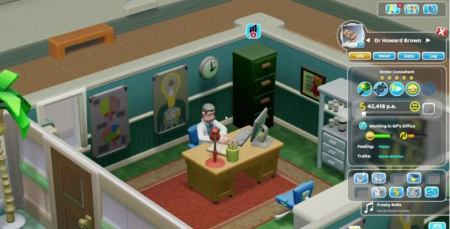
In general, it is no different from a regular hospital, but in the game you can influence some processes. If the accuracy of the diagnosis exceeds a certain percentage, a second visit to the general practice office can be skipped. Then the patient is immediately sent for treatment. The Diagnosis Threshold for Treatment can be defined in the hospital policy settings. And everything will happen automatically.
At the same time, the patient can be referred for treatment manually. In a situation where there is a large queue at the general practice office, this is a completely workable way to deal with it. But there is no guarantee of treatment success in this case. The size of the warning queue can be further defined in the game settings (Queue Warning Length).
Any currently available doctor can work in a general practice office, regardless of his qualifications. However, specialization in general practice has a significant impact on success in establishing a diagnosis. In my hospital there were doctors with such qualifications of the 2nd and 3rd level.
What else can affect diagnostic success?
Success in diagnostics can be influenced not only by the skills of the staff, but also by the equipment of the office. Using the in-game currency Kudosh, you can unlock the Medical Cabinet and place it in the general practice office. This item increases the success of treatment (Treatment) by 1% and the success of diagnosis (Diagnosis) by 1%. The game guides recommend placing a first aid kit in all diagnostic and treatment rooms, where possible. For example, in the wards (Ward), in the diagnostic room (Diagnosis Room) and others.
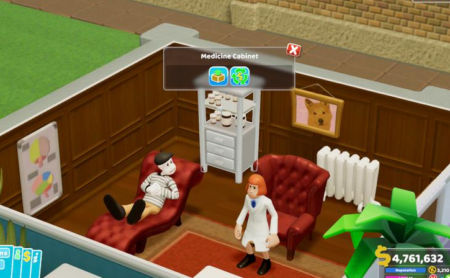
What’s wrong with the doctor?
When Dr. Brown runs out of energy, he completes the appointment and goes on a break, which is measured in days in the game and by default is 21 in-game days. During this break, Dr. Brown visits the restroom and cafe. At the end of the break, the doctor returns to work, but not to the general practice office, but to the DNA Laboratory.

Only a doctor qualified as a geneticist can work in a DNA laboratory. There are many offices with special qualification requirements in the game. For example, only a doctor qualified as a surgeon can work in surgery, and in psychiatry – a psychiatrist.
Taking into account this feature, highly sought after specialists may be prohibited from working in all other offices except the specialized one. This is available in the game settings and for each hospital employee. But you need to remember that such interference can affect the happiness (Happiness) and boredom (Boring) of the employee in a negative way. In my hospital, I tried changing these settings several times, but honestly it only got worse.
The DNA laboratory is both a diagnostic and treatment room for a wide range of diseases. For example, people are sent to a DNA laboratory to diagnose Cubism or to treat the Touch of Midas. In the office settings, you can choose her specialization: Diagnostics and treatment without division or one of the options. The guides recommend building two laboratories in the hospital, where one will specialize in diagnostics and the other in treatment.
The office is very profitable for the hospital. Therefore, the more patients that pass through the DNA laboratory, the more the hospital earns. To attract patients to the laboratory, the marketing department can launch an appropriate marketing campaign.
There are three types of marketing campaigns in the marketing department. General, to improve the reputation of the hospital, campaigns to attract patients with specific diseases and campaigns aimed at staff, for example, to attract special nurses or a ghost hunt campaign. The cost of each campaign is quite high – from 10 thousand dollars and above. Therefore, I try to launch campaigns to attract patients who require the most expensive treatment. For example, DNA laboratory or surgery patients.

What’s next for Dr. Brown?
Dr. Brown completed an appointment at the DNA lab, looked for a job at the hospital (Looking for Work), visited the restroom, and looked into the staff break room. And then he resumed appointments at the DNA laboratory, but located in a different building. During the appointment, the doctor encountered a machine malfunction, and one of the cleaners was called in to repair it.

Having finished in the DNA laboratory, Howard Brown went to work in the general practice office. I didn’t want to watch the routine again, so I sent the doctor to training, which takes place in the hospital in a special training room (Training Room).
Employee training is not always available, but only if there is a free and active slot in his skills. The slot (Ready for training) becomes active upon promotion, but can be active immediately upon hiring, which is very useful if a specialist with special qualifications is needed in the hospital. As a rule, I try to hire a student or junior with an active slot and immediately send him to training in order to get the specialist I need.
You can send an employee for training manually, but you can also wait for an offer from the game. I try to constantly train my employees and, having completed one course, immediately launch a new one.
All possible qualifications and personal skills in the game are available for training, depending on the employee’s position. A doctor studies qualifications available only to a doctor, a nurse – only to a nurse , etc.
You can appoint a hospital employee with the necessary qualifications as a lecturer or invite an outsider, but in this case he will have to pay (10 thousand dollars for the lecture and 5 thousand dollars for each listener).
The speed of learning is influenced by both the skills of the employee, for example, an employee with an advanced level of training (Training Masterclass) learns faster, and the environment of the training room. For example, an Encyclopedia Bookcase, Anatomy Model, Display Skeleton and other items increase the speed of learning.
In my game, the training room is one of the first to be built in a hospital, after the toilets and staff room. At some levels it is mandatory, because there are never specialists with the necessary qualifications on the labor market. All that remains is to train them in their own hospital.
What’s next for Howard?
After completing his studies, Dr. Howard Brown again went in search of work in a hospital (Looking for Work). He had been unhappy with his salary for some time now, so I had to manually increase it. This is where his story ends in the video. And the next ones will be dedicated to the nurse and the cleaner
